Piracy and Illegal Fishing in Peru’s Tropical Pacific Sea
This commentary comes from new contributors Emi Koch and Marco Ruiz-Serkovic. Emi and Marco describe an oft overlooked aspect of security challenges in the maritime space – the conflict between artisanal, or community level resource use, and industrial scale fishing. Small scale fisheries account for half of the global fish catch and 90 percent of direct employment within the fisheries sector. Beyond the numbers, the people involved in these fisheries are often the ones most intimately associated with the resource and also most impacted by conflict over it. The story that Emi and Marco tell here is a reminder that sustainability and security go hand in hand and that those most affected are not always the most visible.
In Peru's Tropical Pacific Sea, two main forces–industrial fishing fleets and foreign pirates–threaten small-scale fishing communities.
“Pirates are lazy,” Justo, a fisherman from Cabo Blanco, Peru, uses his teeth to sever a stubborn piece of fishing line he’s successfully secured to a single hook. “These people like the easy life… stealing. They surround you, take your fishing gear, any electronics. If you resist, they kill you.”
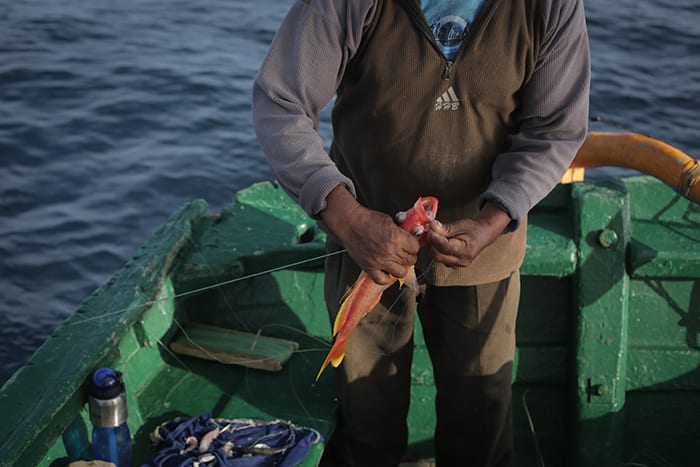
Justo’s humble boat seesaws gently in the sea, as the heavy sails fold and breathe open in today’s favorable winds, propelling the traditional barco de vela through one of the world’s most productive marine ecosystems. In Peru’s Mar Tropical de Grau__, the cold Humboldt Current encounters the warm Southern Equatorial Current along the coastal states of Piura and Tumbes, creating a particular environment of transition with high concentrations of nutrients that favors a rich, unique biodiversity. For generations, Justo’s family has navigated these sapphire waters and survived from the marine resources they’ve traditionally extracted from beyond the surface.
Their community, Cabo Blaco, looks unassuming, squeezed in-between rugged desert cliffs and the pounding surf. Yet this fishing villages once hosted Hollywood’s A-list celebrities such as Marilyn Monroe, John Wayne, Humphrey Bogart, Joe di Maggio and even a writer, Ernest Hemingway. Apart from its solitude, this stretch of desolate coastline offered adventure–the chance to hunt 1000 pound marlins and massive blue fin tuna not a mile or more from shore. But with the crash of Peruvian anchoveta fishery in the late 1960s due to changing ocean conditions and overfishing, came the billfish’s decline as well. The hype around Cabo Blanco lessened and the celebrities left, leaving Peru’s local artisanal fishery to secure and sustain what remained.
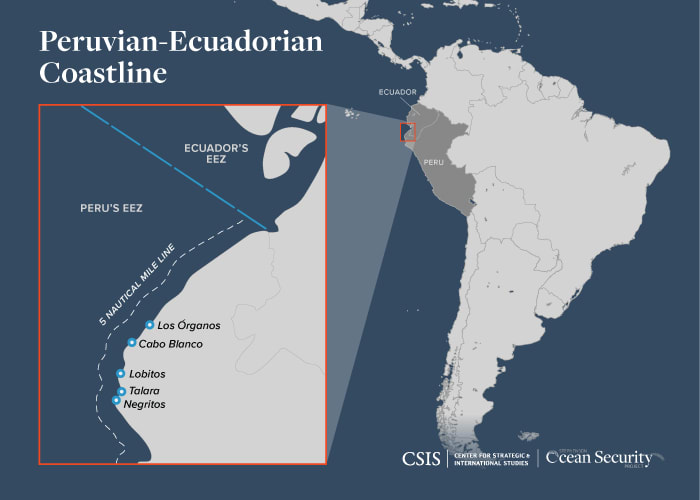

However, today, two main forces–industrial fishing fleets and foreign pirates–threaten small-scale fishing communities like never before and fishermen, like Justo, are struggling to stem the tide.
Over the last decade, an increase in fishing effort by mechanized fleets like trawlers or “Bolicheras1” has resulted in a depletion of fish stocks and tensions with local artisanal fishers, in addition to petitions from the industrial sector to minimize federal protections for small-scale fisheries. By the Peruvian government’s definition, artisanal fishers are individuals who engage in primarily manual fishing activities purposed only for direct human consumption in the local markets with particular fisheries for export such as the Mahi-Mahi. There are more than 16,000 artisanal fishers in the northern region whose livelihoods depend on the sea.
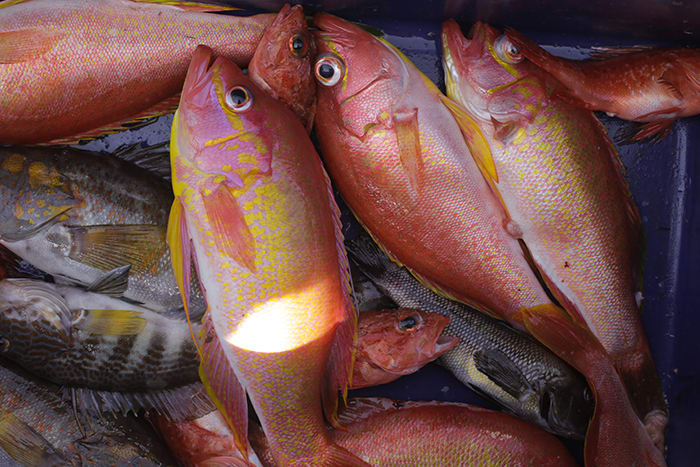
In 1992, the Peruvian Ministry of Fisheries declared a zone exclusively for artisanal fisheries, understood as the zone from the shoreline out five nautical miles into the sea. Therefore, all purse seine boats and industrial trawlers (except those targeting shrimp) were banned from the coastal, nearshore waters. However, with deficient enforcement and further advances in technology, the illegal fishing fleets continuous enter the exclusive zone reserved for artisanal fishermen and harvest more fish in one day than traditional fishers can in fourteen.
In 2016, officials in Tumbes uncovered 140 unregistered bolicheras boats purse seining fish vessels within the five mile zone. Moreover, last year, two Peruvian naval patrol boats carried out 55 operations and intersected 241 vessels fishing illegally within the exclusive five mile zone along the state of Piura. Local artisanal fishermen admit to slashing their nets at times when they come close enough to an industrial vessel. With the height in fishing pressure, mechanized fleets now demand rollbacks to Decreto Supremo 017-92-PE2 allowing trawlers and purse seine fleets to fish as near as one mile from the shoreline.
The Tropical Pacific Sea supports 70 percent of Peru’s marine biodiversity, and supplies the majority of domestic seafood markets. However, inadequate exploitation, illicit fishing activities, oil exploration and development jeopardize the region’s ecological sustainability and the food security of its fish-dependent communities. And now, there’s piracy.
In 2015, Peruvian journalists from El Comercio reported that in the past 15 years, 50 fishermen were murdered by pirates mostly coming from southern Ecuador, including José Pizarro, who was shot in the head as he tried to help his father, who was beaten by raiders. With the five miles exclusive artisanal fishing zone pillaged by illegal fishing fleets, artisanal fishermen in traditional sailboats, like Justo, are forced to sometimes venture further out to sea. “You used to go out there calmly… but now, no way. In pirate waters, you risk everything.” Justo shrugs his shoulders.
In 2016, El Comercio reported that each month, an average of two assaults perpetrated by pirates on artisanal fishing boats occurs. However, the Peruvian government has yet to adopt measure that might safeguard small-scale fishers against armed robbery or murder at sea. Moreover, there’s little to no information –only speculation–concerning why the sudden surge in piracy, who these pirates are, their backgrounds or their reasons for entering Peruvian wartime jurisdiction to attack small-scale fishing vessels, etc.
If you ask Justo or speak with others on the piers, these pirates could have been fishermen who followed their fish stocks south as populations migrate closer to the poles with warming sea waters. Others believe these men have always been pirates with a blatant disregard for laws, including those statues that delineate national boundaries. With a serious lack of law enforcement, pirates find it particularly convenient to loot in Peruvian waters and target artisanal fishing vessels given their already vulnerable status.
Too Big To Ignore Project Director Dr. Ratana Chuenpagdee argues that small-scale fishers often find themselves in a disadvantageous position relative to other actors, especially those competing for the same maritime space, resources, and government’s attention. Like in many other countries, artisanal fishing in Peru is considered a low-class occupation. Small-scale fishing villages lack adequate infrastructure and live in poor conditions.
A legacy of colonial power structures supports the kind of poverty most natural resource dependent communities experience today. Systems of authority politically marginalize and can manipulate through corruption, serving ultimately to benefit landowners for growth and development over traditional hunters and gather communities. The ocean is complicated because there are no fences, only laws written on paper unless otherwise felt through enforcement. However, Recent violent pressures such as piracy and surmounting conflicts between fishers at different scales now demand more constructive, participatory community-based approaches and effective strategies for human security.
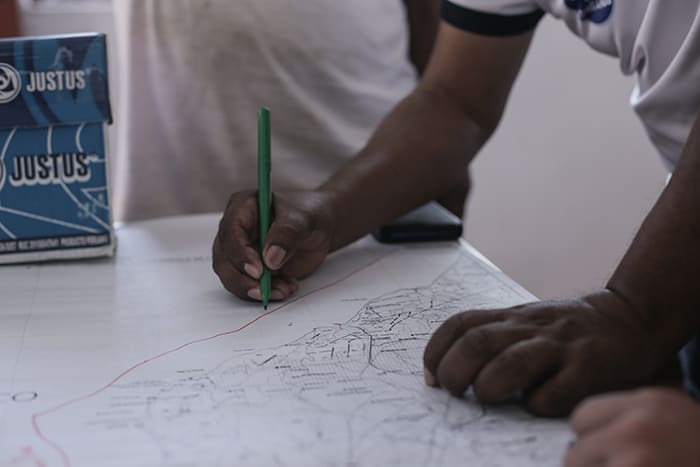
This past January through May, Marco Ruiz Serkovic with the nonprofit Beyond the Surface, facilitated participatory community mapping workshops with five artisanal fishing villages along Peru’s Tropical Pacific Sea to better understand the distribution of their marine resources and how conflicts take place and over which traditional fishing grounds. The workshops were part of Festival Somos Mar, Beyond the Surface’s’s inaugural ocean literacy and audiovisual arts festivals which toured five local schools along Peru’s Mar Tropical de Grau in an effort to establish stronger and collaborative conservation management strategies for social-ecological wellbeing. The mapping exercise itself served as a communication tool for more engaged, informed conversations with local stakeholders while the maps as a product serve as traditional knowledge data to support the process to establish a well-monitored and enforced Marine Protected Area within the region.
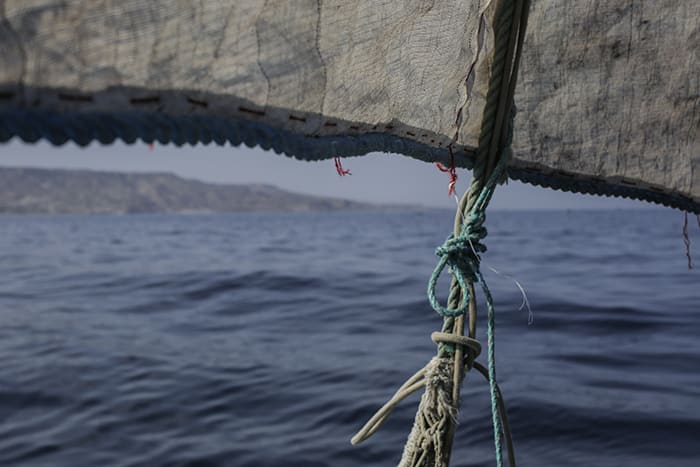
It is necessary to mention the need to increase efforts to empower artisanal fishermen and contribute to their socioeconomic development in a way that also assures the sustainability of marine resources for next generations to come. This is a complex task, considering the intrinsic nature of the ocean and its common access to resources by multiple stakeholders. Exercises of community mapping become an opportunity to understand local knowledge and communicated in a scientific vehicle that needs to be taken into account by decision-makers at different government levels.
The Law of the 5 Miles
Piracy & IUU Fishing

